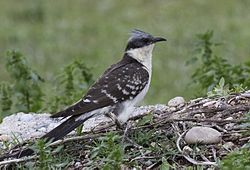Distribution
Clamator cuckoos are found in warmer parts of southern Europe and Asia, and in Africa south of the Sahara Desert. These are birds of warm open scrubby habitats, but some species are at least partially migratory, leaving for warmer and wetter areas in winter. [5]
These are large cuckoos, all at least 33 cm (13 in) long, with broad chestnut wings and long narrow tails. They are strikingly patterned with black, white and brown plumage. The sexes are similar but the juvenile plumages are distinctive. The two African species each also have two distinct colour morphs, light and dark.
All the Clamator cuckoos are brood parasites, which lay a single egg in the nests of medium-sized hosts, such as magpies, starlings, shrikes, laughingthrushes, bulbuls and babblers, depending on location. Unlike the common cuckoo, neither the hen nor the hatched chick of Clamator species evict the host's eggs, but the host's young often die because they cannot compete successfully with the cuckoo for food.
These are noisy birds, with persistent and loud calls. They feed on large insects, with hairy caterpillars, which are distasteful to many birds, being a specialty.
This page is based on this
Wikipedia article Text is available under the
CC BY-SA 4.0 license; additional terms may apply.
Images, videos and audio are available under their respective licenses.








